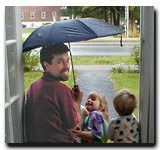October's Sustainable Living Tip
Collect your leaves for making great compost. For quick results, make a pile at least three feet tall and three feet in diameter, add a compost activator, water thoroughly, and turn every few days. Another option is to allow your leaves to dry in the sun, then collect and store them under cover or in garbage cans for use throughout the year. Dry leaves are a good source of "browns" to add to your kitchen "greens."
Facts about Cold Weather Composting
- To make compost, you W-A-N-T four things: water, air, nutrients and temperature.
- Now that fall has arrived, outdoor temperatures start to fall below the range that supports composting. You can still collect materials, but the composting action will slow down the colder it gets.
- Making a big pile of leaves helps keep the temperature in the center of the pile high enough to complete the composting process before winter comes.
- The trick to successfully composting fall leaves is to ensure that you remember to provide the water, air and nutrients needed, in addition to building a large enough pile that will retain heat.
- Water is essential to making compost. You'll need to water your pile of leaves to get things started, and you may need to add water every few days. Building a pile in the sun will help with heat, but will require extra water. Building the pile in the shade will retain more moisture, but doesn't take advantage of the sun's energy for heating things up. Some people like to build their pile in the sun and cover the top with black plastic. This keeps some moisture in and also collects heat to keep those microbes toasty.
- Periodically turning your pile will allow air to circulate. Aerobic microbes require oxygen to do their work. In the absence of oxygen, anaerobic microbes take over. If that happens, be prepared for odors. Ensure an adequate supply of oxygen for your microbes by turning your pile every few days. And if odors do develop, remember the best remedy is fresh air.
- A pile of leaves by themselves won't compost as quickly as a pile of leaves with some added nutrients. Compost activators supply the missing nutrients--mainly nitrogen. Other sources of nitrogen include manure and kitchen scraps. If your leaf pile doesn't seem to be "cooking," try adding water and an activator to speed things up. But once temperatures fall too low, if your pile isn't cooking you may just have to wait for warmer weather.
- Besides building a big compost pile, you have other good options for using your leaves. Shredding them and using them as mulch around bushes and trees, or on garden beds, is a simple and sustainable approach. After all, your trees are expecting their leaves to feed their roots for next year.
- Another option is to store your leaves to use when you take your kitchen compost out. Whenever you empty your compost pail from your kitchen, it's a great idea to cover your scraps with dried leaves. Now is the time to collect those leaves for use the rest of the year.
- If you shred your leaves they'll take up a lot less space, and break down into compost quicker when you add them to your compost pile. You don't have to buy a shredder; a weed wacker in a garbage can works well. Just remember to wear eye protection and be prepared to get covered in little leafy bits.
- We're often asked whether you can continue to add things to your compost pile in the winter. The answer is yes! Just don't expect much to happen. On the positive side, you don't have to worry about odors once things start freezing. That means you don't have to be as concerned about adding browns to your pile. Late fall and winter is the time of year when you can "dump and run" with your kitchen compost pail and get away with it. The rest of the year, it's a better idea to cover your kitchen scraps with a layer of "browns" (shredded leaves or sawdust or the like).
- If you're the type that doesn't want to just wait until spring for your compost, consider bringing your composting action inside. Worm bins are a fun choice. You can use leaves as the top dressing in your worm bins. Simply bury your food scraps under the leaves and let worms eat your garbage. In a few months, your hard-working pet worms will turn both your scraps and your leaves into beautiful castings.
- If you start your garden from seeds, you really ought to try worm castings for your seedlings. My favorite mix is half and half worm castings and coconut fiber (also called "coir"). Many people consider coir to be more sustainable than peat moss. Some peat bogs are being harvested faster than the peat forms. Coir, on the other hand, grows on coconut trees--it's the stringy stuff in the coconut husk. Plus, if you think about it, every coconut is just a big seed. The coir is designed to help that seed grow. So it makes sense to use coir for seedlings.
- A great spot for a worm bin is down in the cellar next to your boiler. Worms like it dark and dank. You can provide a good home to some deserving invertebrates and save yourself the hassle of taking your kitchen scraps outside this winter by keeping a worm bin.
- Now is the best time to start a worm bin to produce castings in time to use for your spring seedlings. It's never too early to be planning for next year's garden!


No comments:
Post a Comment